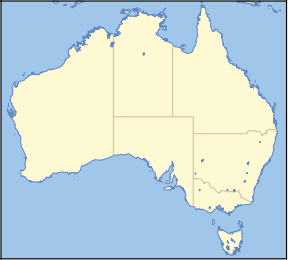- Muogamarra Nature Reserve
-
Muogamarra Nature Reserve Nearest town/city Cowan, New South Wales Coordinates 33°33′12″S 151°11′10″E / 33.55333°S 151.18611°E Area 22.74 km² Established 29 October 1954 Managing authorities New South Wales National Parks and Wildlife Service Official site Muogamarra Nature Reserve Muogamarra (pronounced Moo-o-ga-marra) is a nature reserve New South Wales (Australia), on the northern edge of Sydney. It lies between the outer Sydney suburb of Cowan to the south, and the Hawkesbury River to the north. It is closed to the public for most of the year, but opens for 6 weekends each year in spring, when there are prolific displays of wildflowers. At other times of the year it is available to groups such as the scouts or to schools for education or special events.
During the weekends that the reserve is open to the public, volunteers provide guided walks around some of the most interesting trails.
The vegetation is mainly dry sclerophyll forest, dry sclerophyll shrubs on rocky areas, and mangroves along the river.
Contents
Aboriginal sites
There are many Aboriginal sites in Muogamarra, especially rock art carvings and grinding stones.
History
In 1836 George Peat was granted 50 acres (20.2 hectares) on the Hawkesbury River at what is now Peats Bight. He built huts and a wharf there, and farmed his land. A dairy farm was then built nearby at Peats Crater.
Founded by John Duncan Tipper in 1934 when he leased 600 acres (2.4 km²) to protect the flora, fauna and aboriginal sites, due to his concern at the loss of Hawkesbury sandstone forest. He named the site 'Muogamarra', which he believed was an aboriginal (Awabakal tribe) word meaning 'Preserve for the future'. This area was at the northern end of what is now the Nature Reserve. Over time Tipper expanded his lease to 2050 acres (8.30 km²). In 1954 the land was given up by Tipper and gazetted as 'Muogamarra Sanctuary'
The 750 acre (3.0 km²) Sir Edward Hallstrom Faunal Reserve was dedicated in what is now the southern part of the Nature Reserve in 1961. This was the work of Allen Strom and Sir Edward Hallstrom.
In March 1969 the two areas were amalgamated into what is now Muogamarra Nature Reserve, under the control of the newly formed New South Wales National Parks and Wildlife Service.
Entry point
There is only one entry point to Muogamarra Nature Reserve:
- Pacific Highway, Cowan
- 33°34′27″S 151°11′29″E / 33.57417°S 151.19139°E
3 to 3.5 km north of Cowan along the Pacific highway, on the left hand side (northbound), a small gravel road with a gate. Inside the gate, a narrow gravel road (accessible to normal cars) leads three kilometres into the reserve, where there is an unsealed carpark, toilets, a small open grassy area and the main information centre. This is where all walking trails begin. An entry fee applies - $10 per adult, $5 per child and $25 per family (2010 prices).
Walks
Muogamarra has several good short day walks:
- Point Loop
- Short, flat loop walk from carpark, with excellent wildflowers. Goes to an excellent viewpoint over Peats Crater and the Hawkesbury River. 2 km
- JD Tipper Loop
- Short mostly flat walk to lookout named for the founder of Muogamarra Nature Reserve views overlooking Brooklyn. 1 km
- Lloyd Trig
- Slightly longer mostly flat walk on an old road built by convict labour to Lloyd Trig Point, with excellent views of the Hawkesbury River area. 4 km
- Peats Crater
- A fairly long walk with 200 m of descent and 200 m of ascent which follows a convict road to the site of George Peat's farm at Peats Crater, which is also an interesting geological feature. 10 km
- Deerubbin Lookover
- A medium length walk with 110 m descent & 110 m ascent along the old Peats Ferry convict road to a rock shelter which provides stunning views over the Hawkesbury 180 m below. 6 km
- Bird Gully Swamp
- A trail which skirts the edge of a 'hanging swamp' containing a unique plant habitat. Also goes to the top of a pretty waterfall and occupation sites of aboriginal Gu-ring-gai people.
See also
- Protected areas of New South Wales (Australia)
- Free online topographic maps of Muogamarra - NSW Dept of Lands Spatial Portal
The Hawkesbury River region, New South Wales, Australia Islands of the Hawkesbury National parks Ku-ring-gai Chase National Park · Muogamarra Nature Reserve · Marramarra National Park · Bouddi National Park · Brisbane Water National ParkExplorers of the region Bridges and ferries Hawkesbury River Railway Bridge · Mooney Mooney Bridge · Lower Portland Ferry · Sackville Ferry · Webbs Creek Ferry · Wisemans FerryAdjoining rivers, bays and creeks Shires City of Hawkesbury · Hornsby Shire · Pittwater Council · City of Gosford · The Hills Shire · City of PenrithEvents Categories:- IUCN Category Ia
- Protected areas of New South Wales
- Protected areas established in 1954
- Rock art in Australia
Wikimedia Foundation. 2010.

